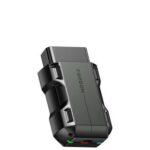For anyone who’s ever enjoyed tinkering with cars, the idea of diagnosing your own vehicle issues at home is incredibly appealing. OBD2 scanners have become synonymous with this DIY approach, promising a window into your car’s health. But as someone with experience in the auto repair industry, particularly with the fascinating world of vehicle diagnostics, I’ve seen firsthand how the landscape is changing. While OBD2 scanners are a great starting point, modern vehicle technology and security measures are creating significant hurdles for the DIY mechanic.
The Basic OBD2 Port: What It Can and Can’t Tell You
The OBD2 port, mandated in vehicles for emissions monitoring, is indeed a valuable tool. With a basic Diy Car Diagnostic Obd2 Scanner, you can access essential engine data. Think of things like fuel trims, engine temperature, and whether your car has passed its emissions checks. This is incredibly useful for identifying common engine-related problems. Many people believe that because their car has an OBD2 port, they can diagnose any issue with a simple scanner. Unfortunately, this is a misconception.
The reality is that OBD2 is primarily focused on engine and emissions-related data. What happens when your ABS light comes on? Or you need to troubleshoot an issue with your instrument panel, traction control, airbag system, or even the transmission? These critical systems operate on different networks, primarily the Controller Area Network (CAN bus), and this data is not readily available through the standard OBD2 protocol. A basic DIY OBD2 scanner simply won’t provide access to these modules and the diagnostic trouble codes they hold.
The Complexity of CAN Bus and Security Lockdowns
Modern vehicles are sophisticated networks on wheels. The CAN bus system allows various modules within your car to communicate with each other, enabling features we now take for granted, like synchronized stereo volume adjustments with speed or speed-sensitive wipers. However, this interconnectedness also presents security vulnerabilities. Unfortunately, instances of car theft via Bluetooth connections to the CAN bus, granting access to start and steal vehicles, have led to significant changes.
In response to these security concerns, automakers are implementing increasingly stringent measures. This often involves security gateways that restrict access to the vehicle’s network. The consequence for DIYers and independent repair shops is significant. Manufacturers are moving towards subscription-based access, requiring technicians to be verified and paid members of their networks (Chrysler, Ford, BMW, and many others). Gaining access now often necessitates using specialized security modules, sometimes requiring physical dismantling of parts of the dashboard to connect these devices before even using a scan tool. This process then involves communicating with dealership servers to verify authorization before allowing deeper diagnostics.
While these security measures are intended to prevent theft and unauthorized access, they inadvertently create barriers for independent repair and DIY diagnostics. We’ve gained convenience features, but at the cost of accessibility to our vehicle’s diagnostic information. Imagine needing to visit a dealership simply to understand why your ABS light is illuminated – a scenario becoming increasingly likely.
Beyond Code Reading: The Power of Bi-Directional Control
Furthermore, it’s crucial to understand that a professional-grade scan tool does far more than just read diagnostic trouble codes. They offer bi-directional control, allowing technicians to actively command and test various vehicle systems. This capability is essential for tasks like activating relays, cycling solenoids, performing throttle body relearn procedures, or purging air from the ABS system. These functions go far beyond the capabilities of basic DIY OBD2 scanners and are often necessary for thorough diagnosis and repair. For instance, resetting fuel alcohol content after switching between E85 and regular gasoline is a procedure requiring bi-directional control.
The Elusive Dream of an Open-Source Solution
Like many in the automotive field, I long for a future where vehicle diagnostics are more open and accessible. The idea of an open-source scan tool, powered by a laptop, that doesn’t require expensive subscriptions or proprietary hardware is incredibly appealing. While creating software for even a limited range of vehicles would be a substantial undertaking, reverse engineering and dedicated effort could potentially yield results, particularly for shops specializing in specific fleet vehicles.
The OBD2 port was initially conceived to provide universal access to vehicle data, a concept mandated by government regulations over 25 years ago. However, regulatory changes are notoriously slow. The growing “Right to Repair” movement offers a glimmer of hope that regulations might evolve to promote greater accessibility in the future.
The Current Reality: Multiple Tools and Frustration
However, in the current automotive repair landscape, particularly for shops handling diverse makes and models across various years, a single DIY car diagnostic OBD2 scanner simply isn’t sufficient. Professional technicians often require multiple scan tools, including high-end options like Snap-on scanners (and their accompanying security modules), along with software subscriptions and updates. Even with these advanced tools, challenges persist, with diagnostic limitations and the constant need to navigate manufacturer security protocols.
The increasing complexity and restrictions in automotive repair are undeniably frustrating, contributing to my own decision to step away from the industry. The ongoing battle with manufacturers over repair access is a significant hurdle for both professionals and DIY enthusiasts alike. While DIY OBD2 scanners have their place, understanding their limitations in the face of modern vehicle technology is crucial for anyone looking to diagnose and maintain their own car effectively.
